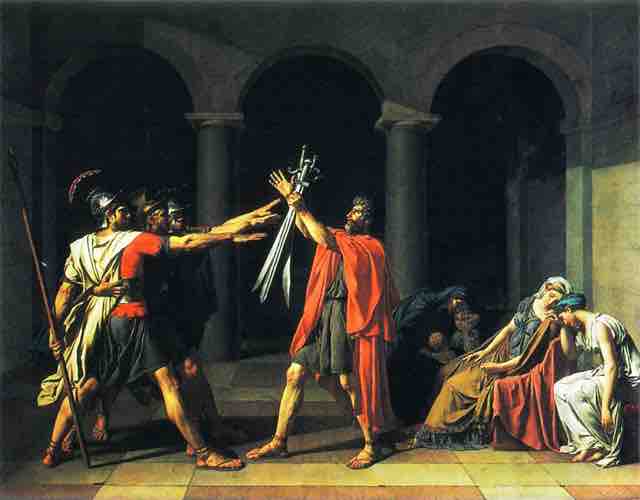Looking to the Greeks and Romans
Neoclassicism is the term for movements in the arts that draw inspiration from the "classical" art and culture of ancient Greece and Rome. The height of Neoclassicism coincided with the 18th century Enlightenment era and continued into the early 19th century. With the advent of the Grand Tour—a much enjoyed trip around Europe intended to introduce young men to the extended culture and people of their world—it became fashionable to collect antiquities as souvenirs. This tradition laid the foundations of many great collections and ensured the spread of the Neoclassical revival throughout Europe and America.
Characteristics of the Style
Neoclasical painting is characterized by the use of straight lines, a smooth paint surface hiding brush work, the depiction of light, a minimal use of color, and the clear, crisp definition of forms. The softness of paint application that was typical of Rococo painting is recognized as the opposite of the Neoclassical style. The works of Jaques-Louis David are widely considered to be the epitome of Neoclassical painting; many painters combined aspects of Romanticism with a vaguely Neoclassical style before David's success, but these works did not strike any chords with audiences. Typically, the subject matter of Neoclassical painting consisted of the depiction of events from history, mythological scenes, and the architecture and ruins of ancient Rome.
David and Ingress, Key Painters of the Movement
Neoclassical painting gained new momentum with the great success of Jaques-Louis David's "Oath of the Haratii" at the Paris Salon of 1785 . The painting had been commissioned by the royal government and was created in a style that was the perfect combination of idealized structure and dramatic affect. The painting created an uproar, and David was proclaimed to have perfectly defined the Neoclassical taste in his painting style, He thereby became the quintessential painter of the movement. In "Oath of the Haratii," the perspective is perpendicular to the picture plane. It is defined by a dark arcade behind several classical heroic figures. There is an element of theatre, or staging, that evokes the grandeur of opera. David soon became the leading French painter and enjoyed a great deal of government patronage

"Oath of the Horatii" by Jaques-Louis David
Neoclassical painting gained new momentum with the great success of Jaques-Louis David's "Oath of the Haratii" at the Paris Salon of 1785.
Jean Auguste Dominique ingress, a Neoclassical painter of history and portraiture, was one of David's students. Deeply devoted to classical techniques, Ingres is known to have believed himself to be a conservator of the style of the ancient masters, as opposed to an innovator of any sort. Examples of his work include the paintings "Virgil reading to Augustus," and "Oedipus and the Sphinx. " Both David and Ingres make use of the highly organized imagery, straight lines and clearly defined forms that are typical of Neoclassical painting during the 18th century.